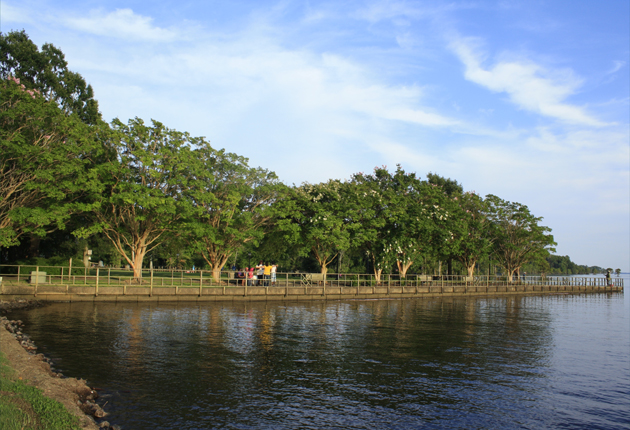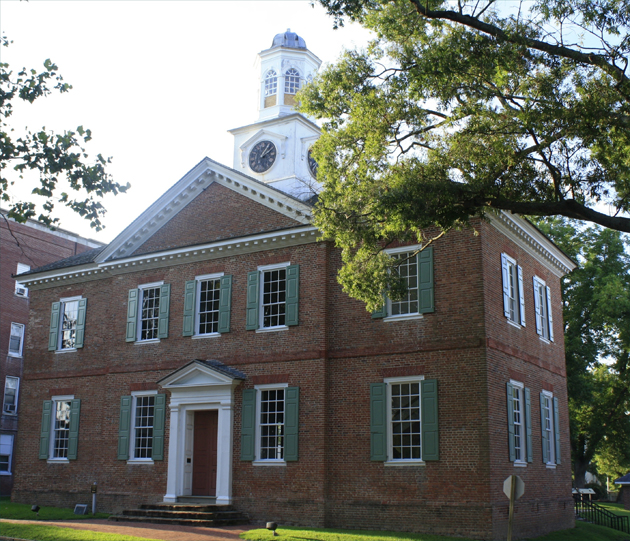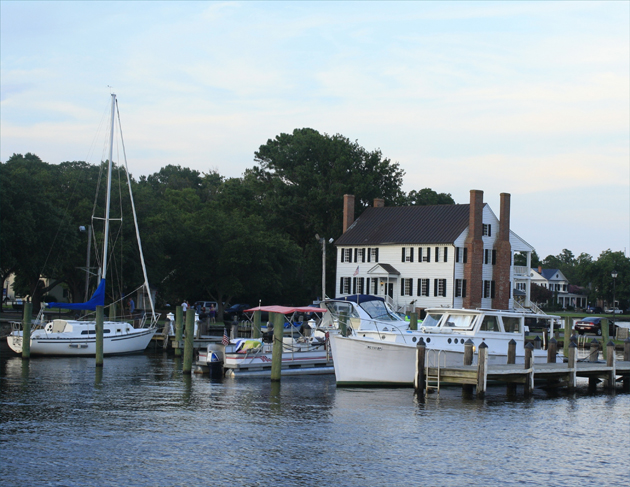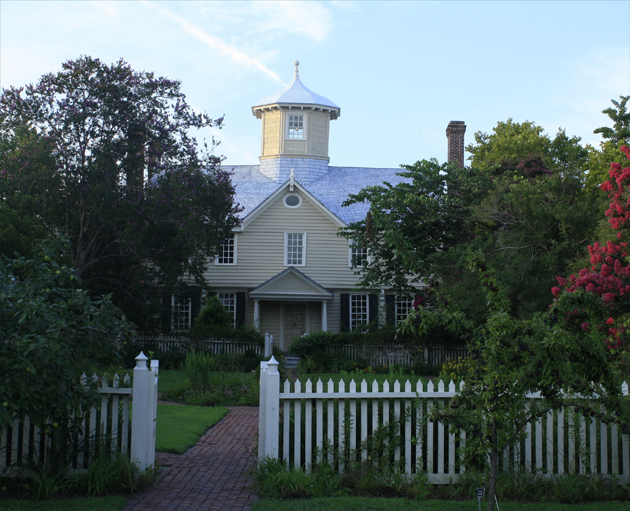Publisher's note: We believe the subject of history makes people (i.e., American people) smarter, so in our quest to educate others, we will provide excerpts from the North Carolina History Project, an online publication of the John Locke Foundation. This sixty-eighth installment, was originally posted, by Jonathan Martin, in the North Carolina History Project.
The first natives in the region were the Weapemeoc, and their central trading town, also called Weapemeoc, was located near the present site of Edenton. The Weapemeoc were a confederation of tribes (the Pasquotank, Perquimans, Poteskeet, and Yeopim) whose territory stretched across the southern edge of the Chesapeake Bay region to land north of the Albermarle Sound. Chief Okisco led the Weapemeoc, whose numbers had reached 1,500, during European settlement of the colonies in the 1600s. The Weapemeoc were eventually driven away by the surging amount of white settlers, and by 1679 only approximately 200 native Weapemeocs remained in present-day Edenton. Frequent battles with neighboring tribes, European diseases, and absorption into other cultures led to the demise of the Weapemeoc tribe.
Established in 1668 as the Shaftesbury Precinct of Albermarle County by incoming English settlers, the Chowan Precinct eventually formed in 1681, and it was named after the Chowan River. Both the river and the precinct were named in honor of the Chowanoac who lived in the area with the Weapemeoc before the mass of English settlers swarmed the area. The seat of government, Edenton (named in honor of
Charles Eden, a royal governor of North Carolina), was originally known as the Town on Queen Anne's Creek. It became known as Edenton after its incorporation in 1722. Edenton, a historic city linked to the colonial and revolutionary era, was the capital of the colony for over twenty years from 1722 to 1743, and it served as the site of the illustrious Edenton Tea Party.
 Edenton waterfront park on Edenton Bay: Above. Edenton Bay from the vantage of the Hayes Plantation Bridge: Below. photos by Stan Deatherage Click the images to enlarge.
Edenton waterfront park on Edenton Bay: Above. Edenton Bay from the vantage of the Hayes Plantation Bridge: Below. photos by Stan Deatherage Click the images to enlarge.

The physical characteristics of Chowan County, along with the annual cultural events and festivals held in the county display the region's importance as a coastal county in North Carolina. Edenton Bay, Dillard Mill Pond, Cherry Point, Bear Swamp, and Bluff Point are interesting natural traits in the county. Some well-known attractions such as the Tea Party Celebration, the Edenton Christmas Candlelight Tour, and the Peanut Festival are held in Chowan each year. In addition to the numerous natural characteristics and annual events, several other communities exist throughout the rest of the county; these townships include Valhalla, Hancock, Tyner, and Ryland.
The historical value of Chowan is evident through the structures and buildings that continue to stand in the county. Known by many architect connoisseurs as an "architectural treasure house," Chowan County holds numerous structures that were constructed over 200 years ago. Most of these historic sites exhibit Georgian architecture, a popular style in colonial times that stressed simplistic symmetry.
The Chowan County Courthouse, the oldest courthouse in North Carolina, was constructed in the late 1760s. Joseph Hewes and Jacob Blount, both county assembly members, developed a plan to construct a new courthouse in Edenton in 1766. Throughout the Colonial and Revolutionary Era, the likes of Samuel Johnston, James Iredell, and other North Carolinian Patriots assembled in the Chowan County Courthouse to discuss independence from Great Britain. Although historians disagree over the building's architect, the courthouse displays simplistic Georgian architecture: a vast rectangular outside frame of Flemish-bond brick, an English ballast stone floor, and whitewashed walls. The courthouse has gone through many renovations, and in October 2004, the site was opened for public use.
 The Edenton County Court House near the waterfront in Edenton, NC: Above. The monument memorializing Chowan County's Confederate heroes, new another waterfront park and boat docks, in downtown Edenton, NC: Below. photos by Stan Deatherage Click the images to enlarge.
The Edenton County Court House near the waterfront in Edenton, NC: Above. The monument memorializing Chowan County's Confederate heroes, new another waterfront park and boat docks, in downtown Edenton, NC: Below. photos by Stan Deatherage Click the images to enlarge.

St. Paul's Episcopal Church, one of the oldest churches in North Carolina, survives in Edenton. Originally constructed in 1736, St. Paul's was constructed as a result of the Vestry Act of 1701. The law commissioned a vestry (a council of twelve members) in each of the five North Carolina colonial districts to tax the landowners. The taxes were used to build churches in the different districts, and in 1701 the Edenton vestry met to discuss the construction of a local Anglican church. The church emanates Georgian-style architecture, it is of rectangular frame, made of Flemish-bond brick, and exhibits arched windows.
The Barker House, built in 1782 by Thomas and Penelope Barker, features a conglomeration of Georgian, Greek Revival, and Federal architecture styles. Presently used as the Edenton Historical Commission's headquarters, the house originally served as the residence of Penelope Barker and her family. Penelope Barker helped coordinate the Edenton Tea Party, a fifty-one assembly entirely composed of women, that sought to support the cause of American independence by boycotting English tea and other goods.
 The Barker House just behind the Boat docks on Edenton Bay: Above. The Cupola House in downtown Edenton, NC: Below. photos by Stan Deatherage Click the images to enlarge.
The Barker House just behind the Boat docks on Edenton Bay: Above. The Cupola House in downtown Edenton, NC: Below. photos by Stan Deatherage Click the images to enlarge.

Other important homes and structures in Chowan include the James Iredell House, the Williams-Flurry House, Bennett's Inn, and the Cupola House.
The people of Chowan County have been invaluable to the formation of not only North Carolina but also the nation. James Iredell, Samuel Johnston, Dr. Hugh Williamson, and Harriet Jacobs all resided in Chowan, and their stories are ones of courage, dedication, and patriotism.
A justice of Supreme Court from 1790 until his death in 1799, James Iredell directed the early formation of the American judiciary, and his guidance was vital in changing the judicial system from its colonial court roots to the more modern entity that the U.S. has today. Iredell, born on October 5, 1751 in England, migrated to Edenton in 1768 because the family company was failing. Samuel Johnston mentored Iredell in the law, and Iredell soon became part of the revolutionary movement. After the Revolutionary War, Iredell would serve as Attorney General of N.C., supported the imposition of judicial review in the Bayard v. Singleton (1787) case, and he eventually became one of the first Supreme Court justices where he served until his death in 1799.
Samuel Johnston, mentioned as James Iredell's teacher of law, was another vital colonial figure who lived at his "Hayes" estate in Edenton during the colonial era. Born in 1733 in Dundee, Scotland, Johnston immigrated with his family to North Carolina, and he would study law under Thomas Barker. Johnston rose to preeminence in North Carolina politics during the revolutionary era, and he eventually served as a delegate to the Continental Congress. Johnston was even offered the chance to preside as president of the assembly, but he decided against it because he wanted to return to his family in Edenton. Johnston became governor of the state in 1787 and he would serve two full terms until he became a U.S. Senator. When he was seventy Samuel Johnston retired from public service and he would die thirteen years later at his Edenton estate on August 17, 1816.
Dr. Hugh Williamson, signer of the U.S. Constitution, was born in Pennsylvania on December 5, 1735, and he would attend the University of Pennsylvania. After graduating in 1757, Williamson toured Europe and taught across Scotland, and he returned to Philadelphia in 1768, when he became part of the intellectual and high-class social club known as the American Philosophical Society. After traveling to Great Britain on the eve of the American Revolution, Williamson finally made his way to Edenton where he was commissioned surgeon general of the North Carolina militia. Once the war was over, Williamson started his political career in North Carolina, and he would represent the state at the Continental Congress in 1783. Several years later Williamson, a devout Federalist, served at the Constitutional Convention with the other North Carolina delegates, William Blount and Richard Dobbs Spaight. Williamson died on May 22, 1819, and he was buried in New York City.
Harriet Jacobs, born as a slave girl in Edenton around the year 1813, wrote Incidents in the Life of a Slave Girl (1861) in which Jacobs detailed much of her childhood in Chowan County. After the death of her owner Margaret Horniblow in 1825, Harriet was taken in by Dr. James Norcom, who Harriet asserted beat her during the time she stayed in his household. Eventually Harriet was able to escape from Norcom, and she hid for seven years in a small attic at her grandmother's, Molly Horniblow, house. After years separated from her children, Jacobs sailed to New York in 1842 to gain her freedom. She succeeded in 1852 and her children were reconciled to Jacobs when she lived in New York. Harriet would pen a memoir of her experiences as a slave, and the book, Incidents in the Life of a Slave Girl, was published in 1861. Although some literary critics question the writing style and abolitionist tone throughout the memoir, the book remains a testament of a slave who lived in North Carolina and experienced a journey to freedom through difficult circumstances.
Sources:
The Formation of The North Carolina Counties (1663-1943). David Leroy Corbitt. Department of Archives and History. (Raleigh, N.C. 1950).
"Chowan County." William S. Powell, ed. Encyclopedia of North Carolina (University of North Carolina Press: Chapel Hill, NC 2006).
"St. Paul's Episcopal Church, James Iredell, Samuel Johnston, Dr. Hugh Williamson, Weapemeoc, Barker House, and Harriet Jacobs." North Carolina Highway Historical Marker Program website. A Division of the North Carolina Department of Cultural Resources. http://www.ncmarkers.com/Results.aspx?k=Search&ct=btn, (accessed on September 19, 2011).
"Historic Edenton: Overview." North Carolina Historic Sites Website. http://www.nchistoricsites.org/iredell/main.htm, (accessed on September 19, 2011).
"Edenton and Chowan County: In the Middle of Something Great." The Edenton Historical Commission Website. http://www.edentonhistoricalcommission.org/history/history.php, (accessed on September 19, 2011).






